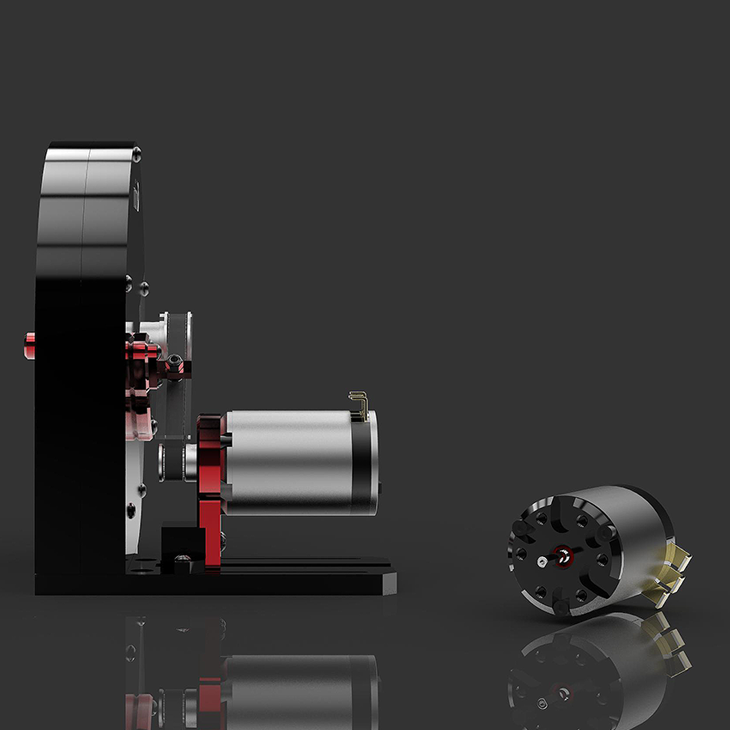
Inertia vs. Brake Dynos
A dyno or dynamometer is a device used to measure the rotational speed (rpm) and torque of a moving motor or engine simultaneously to calculate the instantaneous power. Most dynamometers use power absorbers like an electric motor, a water brake, or an eddy current. These absorbers apply a specific load to the motor or engine, estimating the resultant torque with a load cell or strain gauge. In contrast, inertia dynamometers use a flywheel mass (inertia) instead of power absorbers to measure the acceleration rate to estimate the resultant torque. The power is then calculated using the resultant torque. The power calculated by the dynamometer is displayed in BHP (Boiler Horsepower) and Kilo Watt (KW). Besides measuring the power generated by the engine or motor, a dynamometer is used as part of a testbed for several activities associated with engine development. Calibration of management controllers of machines and tribology are typical examples.
Talking about dynamometers, let's compare two significant types of dynamometers. These are inertia dynamometers and steady-state dynamometers. By the way, there are essentially two other kinds of each dyno based on different configurations. These include engine dynos and chassis dynos. In engine dynos, the engine is connected straight to the dynamometer. In contrast, chassis dynos compute the engine output at the wheel. But here, we will compare inertia and steady-state dynamometers in terms of definition, working principle, and advantages and disadvantages.
Inertia Dynamometer – Definition and Working Principle


The inertia dynamometer proceeds with the fixed inertial mass load. This dynamometer is mainly streamlined to calculate the power required to start or accelerate the set amount of mass load. For this purpose, the inertia dynamometer uses a computer to record the acceleration rate along with rpm. Using the inertia dynamometer, the testing range of the engine starts a little above the idle position (not at zero rpm) to its maximum rpm. While considering the rpm and torque, the graph for power output is plotted on the computer screen. That is how the chart looks like:

At the same time, inertia dynamometers persistently expand to have accurate and real-time testing results for applications in racing cars. As inertia dynos comparatively offer a closer simulation of dynamic conditions created by the engine's acceleration under the load, it brings more accurate and repeatable results on numerous occasions.
Advantages of Inertia Type Dynamometer
Inertia dynamometers are widely used in diverse industries because of their overwhelming benefits. Along these lines, here are some of the benefits of Inertia Type dynamometer:
-
Simply Constructed. The inertia dynos are the cheapest and most straightforward. A large flywheel, always of the same size, is mounted on an axle. It is then connected to an engine through wheels. The simple construction of inertia dynos reduces the need for maintenance. Meanwhile, it is faster and primarily preferred because of a more extensive portrayal of the torque/power curve.
-
Identify Multiple Factors. Majorly, dynos are streamlined to measure the power output or forces that are generated by the engine. And with inertia dynos, power output, torque, and rpm can get measured accurately. Two of the factors should be known to ascertain the value of the third factor.
-
Diverse Capability of Testing. Inertia dynamometer possesses the ability to test any of the small-sized motors. The only thing is selecting the suitable configuration of the flywheel, motor holder, and pulley.
- High Suitability. Inertia dynamometers are highly suitable for robotics, the radio control industry, power equipment, and the medical industry. Hand in hand, it is highly ideal for small-sized motor applications. The small size and economical price attract many sectors to use it for specified purposes.
Disadvantages of Inertia Dynamometers
- Used only for wide-open throttle (WOT) tests.
- Inertia dyno does not allow the examination of the car at a constant speed. It means that the acceleration or deacceleration is NOT zero.
- Only works while the engine is under acceleration.
- The load can be increased freely. However, it might worsen the accuracy.
- Frictional losses (mechanical and aerodynamic frictional losses) and inertia might be two factors affecting the power output of an engine or motor, not calculated by the load cell.
Steady-State Dynamometer – Definition and Working Principle


When it comes to the brake dynamometer, the prime mover (PM) remains under the variable load applied by the dyno. This applied load measures the ability of the prime mover to hold or move the rpm associated with the 'Braking Force' applied. The whole system is connected to the computer that keeps on recording the applied braking torque to calculate the engine's power based on the information provided by the speed sensor and 'strain gauge.'
Moreover, steady-state is one of the essential conditions that works under the brake dynos. In steady-state conditions, the engine is set at specified rpm for a required amount of time. This process is done using variable brake loading provided by the power absorber unit (PAU). In short, the steady-state condition for dyno is a kind of test performed using brake dynos.
Using the steady-state dynamometer, the testing range of the engine starts at a preferred rpm. Then a load is applied to the engine and the load cell accurately measures the torque, and the output is plotted on the computer screen. That is how the chart looks like:

So, the primary purpose of inertia dynos and the steady-state condition is almost the same. However, the choice between these two depends upon the nature of use. Above all, it is worth remembering that steady-state is only a condition satisfied utilizing a brake dynamometer. On the other hand, the inertia dynamometer relates the engine's acceleration to measure the torque and power.
Advantages of Steady-State (Brake) Dynamometer
Like the inertia dyno, the steady-state (brake) dyno also has some of its advantages. Accordingly, here are some of the critical benefits of a steady-state dynamometer:
-
Constant Speed. Steady-state dyno has the ability that an engine can be held and loaded up at a constant speed. It means that the acceleration is ZERO. This ability can be instrumental in knowing a miss at a specified rpm and the engine's tuning for maximum possible power at a specified speed.
-
Testing of Different Equipment. Steady-speed testing is suitable to test different equipment. It may include generators, tractors, water pumps, and any equipment operating at constant rpm and steady load for a longer run.
- Sensors used for Accurate Results. While the engine is running, the dynamometer exerts a braking force on the machine. Furthermore, a load sensors on the dynamometer is used to measure the torque and speed accurately. Once these values are known, the output of engine power can get measured easily.
- Best for High-Profile Applications. Brake dyno offers accurate results with the help of load sensors and actuators. Thus, the process can be made suitable for high-profile applications like aircraft, racing applications, cars, etc.
Disadvantages of Steady-State Dynamometer
- Expensive and more complex dynos compared to inertia type dynamometers.
- Regular calibration of load cell is required as per schedule. Otherwise, the results can be less accurate.
- Braking mechanism produces a lot of heat that needs to be dealt with.
Final Words
Inertia and steady-state dynamometers are used majorly to configure the different forces generated by the engine. Both types have their specified applications, working principles, advantages, and disadvantages, as discussed above. Inertia dyno gives a true representation of what the "road" sees and Steady State dynos gives you a true representation at a constant rpm (Zero acceleration). Nevertheless, the selection depends upon the nature of use.







